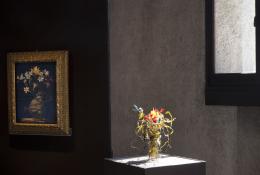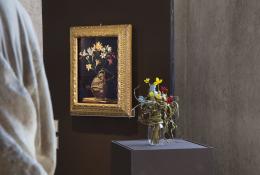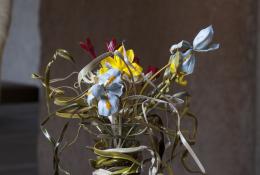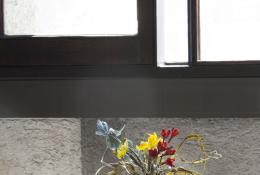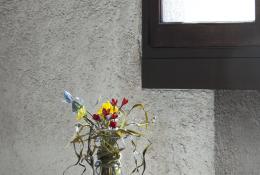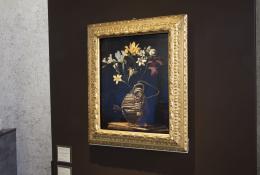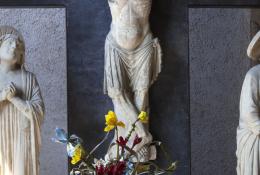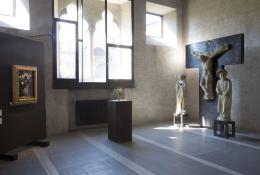OSPITI IN GALLERIA. Il Maestro della Fiasca di Forlì e Lilla Tabasso
The extraordinary works presented here suggest to the visitor, through the lens of the silent life of the floral world, a reflection on the ephemeral condition of human nature. These two masterpieces are exhibited in an unprecedented display within the “Ospiti in Galleria” format at the Museo di Castelvecchio in collaboration with the Civic Museum of San Domenico of Forlì and the Venetian gallery “Caterina Tognon Arte Contemporanea”. Exhibited in the Sculpture Gallery, the works dialogue with the monumental Crucifixion by the Master of Santa Anastasia, a pinnacle of 14th-century Veronese sculpture and a dramatic investigation of truth about pain and death.
Maestro della fiasca di Forlì, Fiasca spagliata con fiori, 1625-1630
Oil on panel, 68,5 x 51,2 cm - Forlì, Civic Museum of San Domenico
Antonio Paolucci (1939-2024) was one of Italy's foremost art historians, a world-renowned museum curator and an indefatigable scholar with a natural talent for communicating knowledge. This exhibition is dedicated to his memory, as he was one of the first to recognise the undeniable pictorial quality of Forlì painting. He compared it to the greatest still life inventions of Italian painting, such as Caravaggio's Basket of Fruit, with which it is often compared. Unlike Merisi's masterpiece, Fiasca creates a mystical atmosphere for the search for truth, where the dramatic reminder of mortality is only seemingly contradicted but ultimately reaffirmed by the extraordinary and fleeting vitality of nature.
Scholars worldwide are aware that the Civic Museums of Forlì house a mysterious and beautiful painting - the Fiasca impagliata by an unknown author. The painting, which is a medium-sized panel (68x51 cm) created around 1625-1630, depicts flowers - a superb triumph of lilies, gladioli, and irises - bundled together inside a broken, uneven, and disordered flask. Behind this impressive coup on the Truth, there is a moral message, an ethical reminder. The beautiful flowers are in an ordinary, vulgar, and broken container. Similarly (here is the conceptual subtlety of the metaphor), in women and men, the highest spiritual values can be found within an ungraceful physique, inside a sick, ugly, unhappy body. What strikes in the painting from Forlì is a sort of vitality, turgor, and splendid expressive tension. The painting in question has been described by the esteemed critic Francesco Arcangeli as a 'tempest of Baroque secretly present but not yet exploded by the constraint of observation'. However, the Fiasca di Forlì has no known author. Even the most refined attribution specialists have been unable to uncover the secret of a work that is unanimously celebrated as one of the absolute peaks of Caravaggio-influenced naturalism. (A. Paolucci)
Lilla Tabasso, Groviglio, 2021
Lamp-hand-worked and modelled Murano glass, 37 x 34 cm - Venezia, Caterina Tognon Arte Contemporanea
Inspired by the painting of the unknown artist of the Seventeenth century, Lilla Tabasso creates a bunch of sparse flowers, with blue and yellow irises, gives itself to the visitor’s gaze, while a sinuous wicker branch twists around the transparent vase that holds them. These fragile and ephemeral flowers, molded in glass and once fresh and luminous, now bow elegantly to the inexorable passing of time. Inspired by De Rerum Natura, a poem by the Latin author Lucretius, Lilla Tabasso, a Milanese artist, designer and biologist, pursues the condition of ataraxia: the attainment of perfect peace of soul by accepting the sublime transience of nature and human life. Through her hyper-realistic floral compositions, obtained by self-learning the ancient art of lampworking, Tabasso makes a meticulous observation of the botanical world, crystallizing the lifeblood that still flows in cut flowers, portrayed in their inevitable withering. The artist’s thoughts rest on the contradictions of human existence, marked by a perennial duality of life and death, splendor and decay, in the silent and fragile life of nature.

